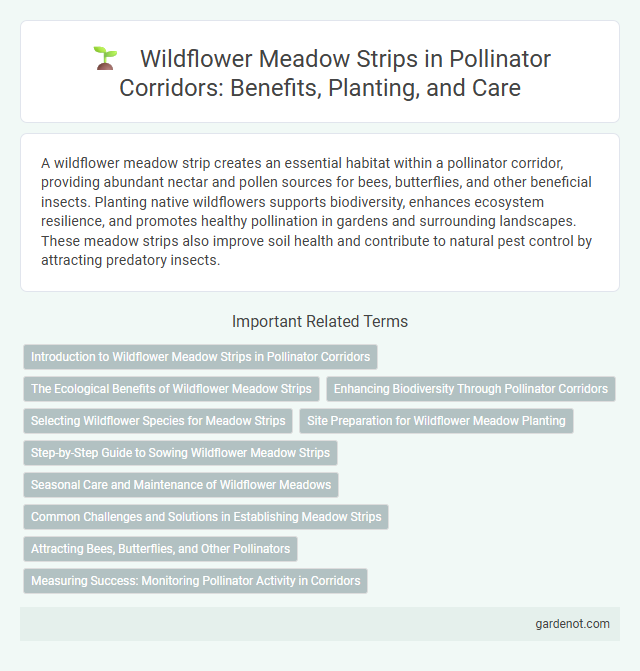A wildflower meadow strip creates an essential habitat within a pollinator corridor, providing abundant nectar and pollen sources for bees, butterflies, and other beneficial insects. Planting native wildflowers supports biodiversity, enhances ecosystem resilience, and promotes healthy pollination in gardens and surrounding landscapes. These meadow strips also improve soil health and contribute to natural pest control by attracting predatory insects.
Introduction to Wildflower Meadow Strips in Pollinator Corridors
Wildflower meadow strips within pollinator corridors serve as crucial habitats offering diverse nectar sources and shelter for bees, butterflies, and other pollinators. These strips enhance biodiversity by supporting native plant species that bloom sequentially, ensuring consistent food availability throughout the pollination season. Implementing wildflower meadow strips contributes to ecosystem resilience and promotes agricultural productivity through improved pollination services.
The Ecological Benefits of Wildflower Meadow Strips
Wildflower meadow strips enhance biodiversity by providing essential habitats and food sources for pollinators such as bees, butterflies, and other beneficial insects. They improve ecosystem services, including pollination, soil health, and water retention, contributing to overall environmental resilience. These strips also act as natural pest control zones by supporting predator species that help manage agricultural pests sustainably.
Enhancing Biodiversity Through Pollinator Corridors
Wildflower meadow strips play a crucial role in enhancing biodiversity by serving as pollinator corridors that connect fragmented habitats. These corridors support a wide variety of pollinators such as bees, butterflies, and hoverflies, ensuring effective pollination services that boost plant reproduction and ecosystem resilience. By increasing floral diversity and providing continuous foraging resources, wildflower strips promote genetic exchange among pollinator populations and strengthen local biodiversity networks.
Selecting Wildflower Species for Meadow Strips
Selecting wildflower species for meadow strips in pollinator corridors involves prioritizing native plants that provide continuous bloom throughout the growing season to support diverse pollinator populations. Species such as Echinacea purpurea, Asclepias tuberosa, and Solidago canadensis offer essential nectar and pollen resources for bees, butterflies, and other pollinators. Incorporating a mix of flower shapes and colors enhances habitat diversity, promoting pollinator health and ecosystem resilience.
Site Preparation for Wildflower Meadow Planting
Effective site preparation for wildflower meadow planting within a pollinator corridor involves soil testing to determine nutrient levels and pH balance, ensuring optimal conditions for native wildflowers. The removal of existing vegetation, through methods such as shallow tilling or herbicide application, minimizes competition and promotes seed-to-soil contact crucial for germination. Creating a well-prepared seedbed enhances wildflower establishment, supporting diverse pollinator species including bees, butterflies, and other beneficial insects.
Step-by-Step Guide to Sowing Wildflower Meadow Strips
Prepare the soil by removing weeds and loosening the top layer to enhance seed germination for wildflower meadow strips. Evenly scatter a diverse mix of native wildflower seeds, ensuring good seed-to-soil contact by lightly raking and pressing the soil. Maintain consistent moisture until seedlings establish, then mow selectively to encourage growth and support pollinator habitat in the corridor.
Seasonal Care and Maintenance of Wildflower Meadows
Seasonal care and maintenance of wildflower meadow strips in pollinator corridors involve timely mowing, selective weeding, and periodic reseeding to ensure plant diversity and prolonged bloom periods. Monitoring soil health and managing invasive species help sustain optimal conditions for native pollinators such as bees, butterflies, and other beneficial insects. Proper mulching and irrigation during dry seasons enhance plant vigor, supporting a continuous habitat within the corridor.
Common Challenges and Solutions in Establishing Meadow Strips
Establishing wildflower meadow strips in pollinator corridors often faces challenges such as soil quality variability, invasive species competition, and inconsistent seed germination rates. Solutions include conducting soil assessments to tailor seed mixes, implementing regular maintenance to control invasive plants, and using native, locally-sourced seeds to enhance adaptability and biodiversity. Proper planning and adaptive management ensure the successful establishment and long-term sustainability of these vital habitats for pollinators.
Attracting Bees, Butterflies, and Other Pollinators
Wildflower meadow strips rich in native blooms create essential habitats that attract bees, butterflies, and other pollinators by providing diverse nectar and pollen sources. Incorporating species such as coneflowers, milkweed, and black-eyed Susans supports pollinator health and promotes biodiversity. These strips enhance ecological connectivity, facilitating pollinator movement across fragmented landscapes and improving crop pollination.
Measuring Success: Monitoring Pollinator Activity in Corridors
Wildflower meadow strips within pollinator corridors serve as critical habitats that boost biodiversity and support pollinator populations. Measuring success involves regular monitoring of pollinator activity through methods such as pollinator counts, species identification, and behavioral observations. Data collected helps assess habitat effectiveness, guiding adaptive management for enhancing corridor connectivity and pollination services.
Wildflower meadow strip Infographic

 gardenot.com
gardenot.com